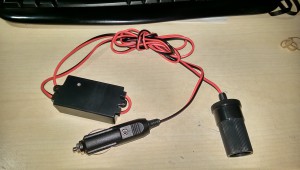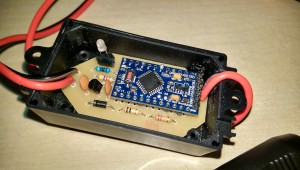Car Auxiliary Power Switcher
I’ve been using a dashcam for almost a year now and right from the beginning I knew that my cigarette socket was not switched with the key. I’ve been using a device made by my friend John to switch the power on and off automatically based on battery voltage. I finally got around to making my own so I thought I would document it.
Very simply all it does is monitor the battery voltage. When it goes above 13.1v after the engine is started, it switches on. When the engine is turned off and it goes below 13.1v it switches off after a short delay. Simple. It saves the hassle of remembering to plug it in and prevents your battery dying by forgetting to unplug it.
Specs:
- 7v-15v input (circuit will work between 7-30v but output voltage will reflect input)
- Arduino Nano (Atmega 328p) running at 256KHz (cpu-scalar from 16MHz)
- 5v low quiescent current regulator for the Arduino
- Red/green bi-colour status LED
- N Channel MOSFET for switching (under the Arduino Nano board)
- 100k / 22k voltage divider for voltage measurement
- Can switch around 3A happily (MOSFET rated at 25A but does not have adequate cooling, wiring or PCB traces)
- Typical 1.7mA power draw current (output off)
Features:
- Turns the output on if input is above 13.1v
- Turns output off when below input is below 13.1v after 8 second delay
- If voltage goes above 13.1v before turning off the delay will reset and output will remain on
- Steady red LED shows when voltage is below 13.1v and the output is about to turn off
- Steady green LED shows when the output is on and voltage is above 13.1v
- Flashing green LED shows when off to indicate >12.5v battery voltage
- Flashing red LED shows when off to indicate <12.5v battery voltage
- Voltage accuracy is around +/- 0.1v
Component List:
PCB:
- 1x Arduino Nano 16MHz 5v
- 1x 5v Regulator (Texas Instruments LP2950-50LPRE3)
- 2x 100nF Ceramic Capacitors
- 1x 1N4001 Diode
- 1x 100k 1/4w resistor
- 1x 22k 1/4w resistor
- 1x 4.7k 1/4w resistor
- 1x 470R 1/4w resistor
- 1x 3mm bi-colour LED (red/green) (plus SIL socket strip if you wish)
Download:


